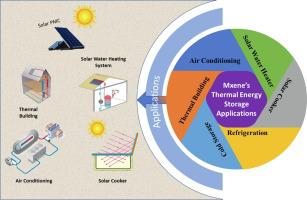Energy Conversion and Management ( IF 10.4 ) Pub Date : 2022-11-08 , DOI: 10.1016/j.enconman.2022.116432 Nadeem Hussain Solangi , Nabisab Mujawar Mubarak , Rama Rao Karri , Shaukat Ali Mazari , Abdul Sattar Jatoi , Janardhan Reddy Koduru , Mohammad Hadi Dehghani

|
MXene is a new and excellent class of two-dimensional (2D) materials discovered in the last decade. The community of MXenes has drawn significant research attention because of its varied chemical structure and outstanding physicochemical characteristics in various fields, including thermal energy storage and environmental remediation applications. In the field of Material science, traditional material used in thermal energy storage devices exhibits several disadvantages, such as low thermal conductivity, reusability, cycling life and thermal storage capability. Therefore, the advanced 2D material MXene, because of various excellent characteristics, is extensively used in thermal energy storage applications. To capture thermal energy for effective use, convert solar energy to electrical or thermal energy, and store waste heat for a specific use, phase change material (PCM) may be used as a latent heat storage system. High-performance composite PCM has recently seen significant development as advanced energy storage materials. The phase change materials are extensively utilized as latent heat storage systems. PCM enables the storage of solar passive and other radiant heat as latent heat within a particular temperature, resulting in lower energy consumption, increased thermal comfort by trying to smooth out temperature changes during the day, and a decrease and shift in peak loads. Paraffin generally has a thermal conductivity in the ranges of 0.15–0.2 W/mK. It increases to 56.8 % by doping silicon nitride (Si3N4) on the surface of organic phase change material paraffin.
This study presents the most up-to-date, comprehensive, and trustworthy information on the role of MXene-based PCM in thermal energy storage applications. This review paper focuses on the thermal energy storage applications of 2D PCM. The thermal energy storage applications included Photovoltaic PCM, Solar water heater systems, Solar greenhouses, thermal Buildings, Cold storage, and air conditioning and refrigeration, respectively. In addition, an extensive summary of synthesis approaches of 2D materials and the effect of coating/incorporating substance loading on their performance was narrated. Furthermore, a brief review of organic, inorganic and ionic liquid based PCM was elaborated. Finally, future challenges and prospects for PCM were presented before the conclusion. Finally, this comprehensive review is helpful for the advancement and application of MXenes in thermal energy storage applications.
中文翻译:

用于太阳能热能存储的基于 MXene 的相变材料
MXene 是在过去十年中发现的一类新型的优秀二维 (2D) 材料。MXenes 社区因其多样的化学结构和突出的物理化学特性在热能存储和环境修复应用等各个领域引起了广泛的研究关注。在材料科学领域,用于热能存储装置的传统材料具有低导热性、可重复使用性、循环寿命和蓄热能力等缺点。因此,先进的二维材料 MXene,由于具有多种优异特性,被广泛用于热能存储应用。为了有效利用热能,将太阳能转化为电能或热能,并储存废热以供特定用途,相变材料(PCM)可用作潜热储存系统。高性能复合 PCM 作为先进的储能材料最近得到了显着的发展。相变材料被广泛用作潜热储存系统。PCM 能够将太阳能被动热和其他辐射热存储为特定温度内的潜热,从而降低能源消耗,通过试图消除白天的温度变化来提高热舒适度,并减少和转移峰值负荷。石蜡的导热系数通常在 0.15–0.2 W/mK 范围内。通过掺杂氮化硅(Si 相变材料被广泛用作潜热储存系统。PCM 能够将太阳能被动热和其他辐射热存储为特定温度内的潜热,从而降低能源消耗,通过试图消除白天的温度变化来提高热舒适度,并减少和转移峰值负荷。石蜡的导热系数通常在 0.15–0.2 W/mK 范围内。通过掺杂氮化硅(Si 相变材料被广泛用作潜热储存系统。PCM 能够将太阳能被动热和其他辐射热存储为特定温度内的潜热,从而降低能源消耗,通过试图消除白天的温度变化来提高热舒适度,并减少和转移峰值负荷。石蜡的导热系数通常在 0.15–0.2 W/mK 范围内。通过掺杂氮化硅(Si 石蜡的导热系数通常在 0.15–0.2 W/mK 范围内。通过掺杂氮化硅(Si 石蜡的导热系数通常在 0.15–0.2 W/mK 范围内。通过掺杂氮化硅(Si3 N 4 ) 在有机相变材料石蜡表面。
本研究提供了有关基于 MXene 的 PCM 在热能存储应用中的作用的最新、全面和值得信赖的信息。这篇综述文章重点介绍了 2D PCM 的热能存储应用。热能存储应用分别包括光伏PCM、太阳能热水器系统、太阳能温室、热力建筑、冷库以及空调和制冷。此外,还对二维材料的合成方法以及涂层/掺入物质负载对其性能的影响进行了广泛的总结。此外,还对基于有机、无机和离子液体的 PCM 进行了简要回顾。最后,在结论之前提出了PCM未来的挑战和前景。最后,



























 京公网安备 11010802027423号
京公网安备 11010802027423号